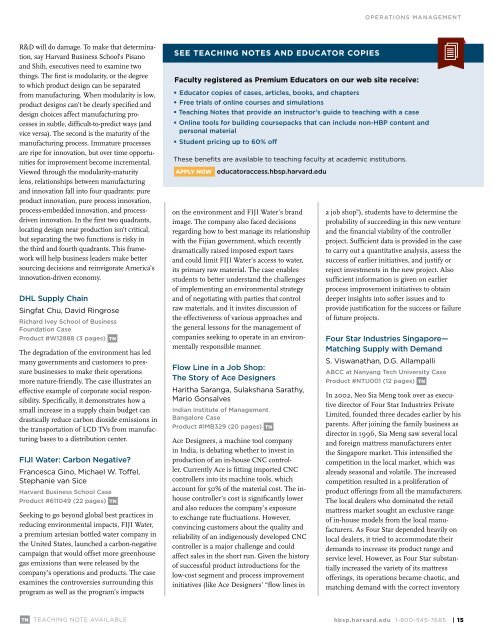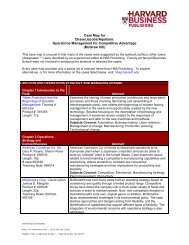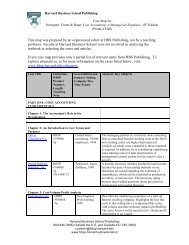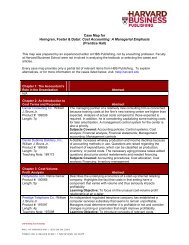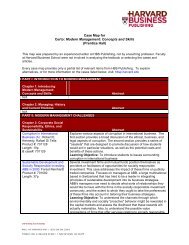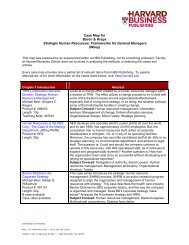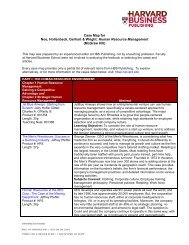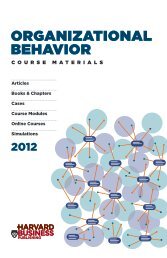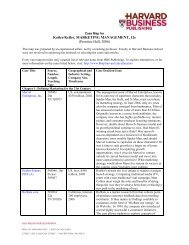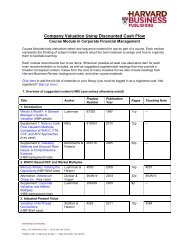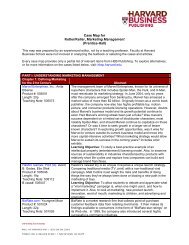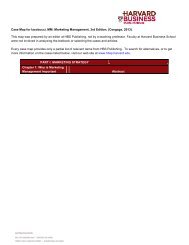teAcHing MATErIAlS - Harvard Business School Press
teAcHing MATErIAlS - Harvard Business School Press
teAcHing MATErIAlS - Harvard Business School Press
Create successful ePaper yourself
Turn your PDF publications into a flip-book with our unique Google optimized e-Paper software.
R&D will do damage. To make that determination,<br />
say <strong>Harvard</strong> <strong>Business</strong> <strong>School</strong>’s Pisano<br />
and Shih, executives need to examine two<br />
things. The first is modularity, or the degree<br />
to which product design can be separated<br />
from manufacturing. When modularity is low,<br />
product designs can’t be clearly specified and<br />
design choices affect manufacturing processes<br />
in subtle, difficult-to-predict ways (and<br />
vice versa). The second is the maturity of the<br />
manufacturing process. Immature processes<br />
are ripe for innovation, but over time opportunities<br />
for improvement become incremental.<br />
Viewed through the modularity-maturity<br />
lens, relationships between manufacturing<br />
and innovation fall into four quadrants: pure<br />
product innovation, pure process innovation,<br />
process-embedded innovation, and processdriven<br />
innovation. In the first two quadrants,<br />
locating design near production isn’t critical,<br />
but separating the two functions is risky in<br />
the third and fourth quadrants. This framework<br />
will help business leaders make better<br />
sourcing decisions and reinvigorate America’s<br />
innovation-driven economy.<br />
DHL Supply Chain<br />
Singfat Chu, David Ringrose<br />
Richard Ivey <strong>School</strong> of <strong>Business</strong><br />
Foundation Case<br />
Product #W12888 (3 pages) tn<br />
The degradation of the environment has led<br />
many governments and customers to pressure<br />
businesses to make their operations<br />
more nature-friendly. The case illustrates an<br />
effective example of corporate social responsibility.<br />
Specifically, it demonstrates how a<br />
small increase in a supply chain budget can<br />
drastically reduce carbon dioxide emissions in<br />
the transportation of LCD TVs from manufacturing<br />
bases to a distribution center.<br />
FIJI Water: Carbon Negative?<br />
Francesca Gino, Michael W. Toffel,<br />
Stephanie van Sice<br />
<strong>Harvard</strong> <strong>Business</strong> <strong>School</strong> Case<br />
Product #611049 (22 pages) tn<br />
Seeking to go beyond global best practices in<br />
reducing environmental impacts, FIJI Water,<br />
a premium artesian bottled water company in<br />
the United States, launched a carbon-negative<br />
campaign that would offset more greenhouse<br />
gas emissions than were released by the<br />
company’s operations and products. The case<br />
examines the controversies surrounding this<br />
program as well as the program’s impacts<br />
tn TEAChiNG NOTE AVAiLABLE<br />
see <strong>teAcHing</strong> notes And educAtor copies<br />
on the environment and FIJI Water’s brand<br />
image. The company also faced decisions<br />
regarding how to best manage its relationship<br />
with the Fijian government, which recently<br />
dramatically raised imposed export taxes<br />
and could limit FIJI Water’s access to water,<br />
its primary raw material. The case enables<br />
students to better understand the challenges<br />
of implementing an environmental strategy<br />
and of negotiating with parties that control<br />
raw materials, and it invites discussion of<br />
the effectiveness of various approaches and<br />
the general lessons for the management of<br />
companies seeking to operate in an environmentally<br />
responsible manner.<br />
Flow Line in a Job Shop:<br />
The Story of Ace Designers<br />
haritha Saranga, Sulakshana Sarathy,<br />
Mario Gonsalves<br />
Indian Institute of Management<br />
Bangalore Case<br />
Product #IMB329 (20 pages) tn<br />
Ace Designers, a machine tool company<br />
in India, is debating whether to invest in<br />
production of an in-house CNC controller.<br />
Currently Ace is fitting imported CNC<br />
controllers into its machine tools, which<br />
account for 50% of the material cost. The inhouse<br />
controller’s cost is significantly lower<br />
and also reduces the company’s exposure<br />
to exchange rate fluctuations. However,<br />
convincing customers about the quality and<br />
reliability of an indigenously developed CNC<br />
controller is a major challenge and could<br />
affect sales in the short run. Given the history<br />
of successful product introductions for the<br />
low-cost segment and process improvement<br />
initiatives (like Ace Designers’ “flow lines in<br />
OPERATIONS MANAGEMENT<br />
faculty registered as premium educators on our web site receive:<br />
Educator copies of cases, articles, books, and chapters<br />
Free trials of online courses and simulations<br />
Teaching Notes that provide an instructor’s guide to teaching with a case<br />
Online tools for building coursepacks that can include non-HBP content and<br />
personal material<br />
Student pricing up to 60% off<br />
These benefits are available to teaching faculty at academic institutions.<br />
APPly now educatoraccess.hbsp.harvard.edu<br />
a job shop”), students have to determine the<br />
probability of succeeding in this new venture<br />
and the financial viability of the controller<br />
project. Sufficient data is provided in the case<br />
to carry out a quantitative analysis, assess the<br />
success of earlier initiatives, and justify or<br />
reject investments in the new project. Also<br />
sufficient information is given on earlier<br />
process improvement initiatives to obtain<br />
deeper insights into softer issues and to<br />
provide justification for the success or failure<br />
of future projects.<br />
Four Star Industries Singapore—<br />
Matching Supply with Demand<br />
S. Viswanathan, D.G. Allampalli<br />
ABCC at Nanyang Tech University Case<br />
Product #NTU001 (12 pages) tn<br />
In 2002, Neo Sia Meng took over as executive<br />
director of Four Star Industries Private<br />
Limited, founded three decades earlier by his<br />
parents. After joining the family business as<br />
director in 1996, Sia Meng saw several local<br />
and foreign mattress manufacturers enter<br />
the Singapore market. This intensified the<br />
competition in the local market, which was<br />
already seasonal and volatile. The increased<br />
competition resulted in a proliferation of<br />
product offerings from all the manufacturers.<br />
The local dealers who dominated the retail<br />
mattress market sought an exclusive range<br />
of in-house models from the local manufacturers.<br />
As Four Star depended heavily on<br />
local dealers, it tried to accommodate their<br />
demands to increase its product range and<br />
service level. However, as Four Star substantially<br />
increased the variety of its mattress<br />
offerings, its operations became chaotic, and<br />
matching demand with the correct inventory<br />
hbsp.harvard.edu 1-800-545-7685 | 15


